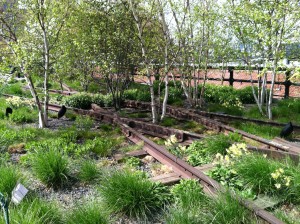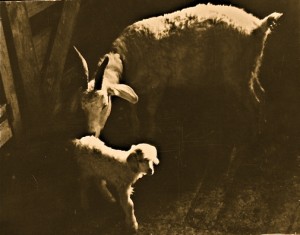It’s 6:30 on a hot and humid August morning. My dogs, Sam and Max, are anxious to get back home, where Bill has their breakfast mixed and waiting for them. They’ve taken care of their “business” and I’m now awake and sweaty after a brisk walk and just as happy that in a few minutes I’ll be back in my air-conditioned abode.
As I turn the corner toward home I notice an old car parked facing out into the street in a driveway to my left. I don’t know the people who live there, but I walk these streets every day and have never seen this aged, black Volvo station wagon before. As I get closer I see its dings and dents, and someone sitting in the drivers seat. The car isn’t parked next to the other cars much further up the driveway and close to the house. This one sits right at the edge of the road as if it’s ready to make a quick get-a-way.
I live in one of Charlottesville’s oldest and most beautiful neighborhoods. The streets are lined with stately tree and in the spring the yards are filled with a riot of color with azaleas, forsythia, Chinese magnolia, dogwood, redbuds, and cherry trees blooming one right after another. Most, if not everyone who lives here feels safe and loves our little community here in the gulch, tucked between several hills.
It’s a 1950’s kind of of a neighborhood. When they’re not in school kids of all ages are out playing together, riding bikes, or shooting baskets without being looked after by overly doting parents. Occasionally a police van drives slowly through the area and though we hear of an occasional nearby car break-in, we who live here, are trusting and don’t live in fear.
This morning there is no one else about except that person in the car. The sun is up and the birds are singing, but it seems that most people are still sacked out or sipping coffee as they read the morning paper. I wonder who that person is in that car and what his business is.
As I pass in front of the car, I notice what looks like the long barrel of a rifle pointing out into the street from the front passenger seat. But I think nothing of it … until I’m about to turn the next corner and begin to feel a rush of adrenalin coursing through my body. I run home, dragging the dogs behind me, who now if they had their way, would stop to sniff every blade of grass we pass.
I tell Bill about what I saw. He says we should call the police, but we look at each other and agree that there must be a rational explanation for the car, the man, and the “rifle.” We’re both thinking, Bad things just don’t happen here.
Brave and brazen, Bill decides to drive around the block to see what’s up. When he returns a few minutes later, he comes in smiling. He tells me that when he drove by the scene of what I now think was all my imagination, the man was out of his car, unloading tree trimming tools. The gun barrel I saw was a long pole he was about to use to trim the neighbors trees.
I was relieved but still distressed and shaken to my core. I’ve suddenly seen my own neighborhood in the shadow of the violence that seems to fill the headlines on a daily basis in this country. That we live in a time when we must be continuously reminded that if we see something suspicious, we must say something, is nothing short of discouraging and often depresses me.
Whether we know it or not, we live in two worlds; the world of home and community where we feel comfortable and safe, and the world we read about or view on tv, in which innocent children and every day good citizens, some whose jobs are to protect us, are shot down for no reason at all. And we can’t always be sure which world we’re in during any given moment.
Had we called the police about the tree trimmer, how would I have felt to learn that he was just an innocent man, getting ready to do his job, but first having a smoke and finishing the last drops of his morning coffee before unloading his tools? I would have felt like a jerk and been kicking myself in the butt.
But how would I have felt if someone in my neighborhood was shot and killed because I never reported what I saw to the police, refusing to believe that bad things could ever happen here?
I know horrific events can and do happen anywhere. And yes, we must say something if we see something that disturbs us and could be harmful to ourselves and other people. It is always better to be safe than sorry.
But constantly being on guard and ready to speak out about the things that frighten or anger us, can make our days darker and our anxiety levels sky rocket.
Perhaps we could grow our awareness, our sense of reality, and stem the tide of anxiety and depression if we also spoke out about the beautiful things we see around us.
Perhaps if the next time we witness an awe inspiring sunset or a person doing good deeds benefiting all creatures and point it out to everyone around us, we can spread the notion that indeed we live in a wonderful world. By sharing the goodness as well as the badness, we can all be happier and live more fulfilling lives. Reality is both frightfully horrible and outrageously wonderful.
We can soften the blow of the horrible by recognizing the beauty that surrounds us.


